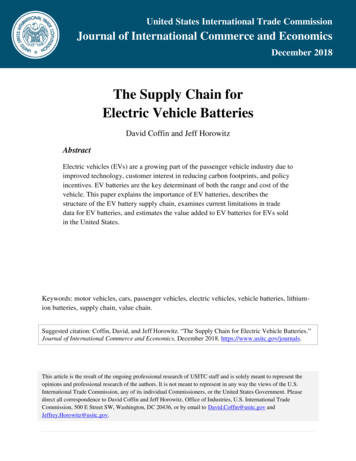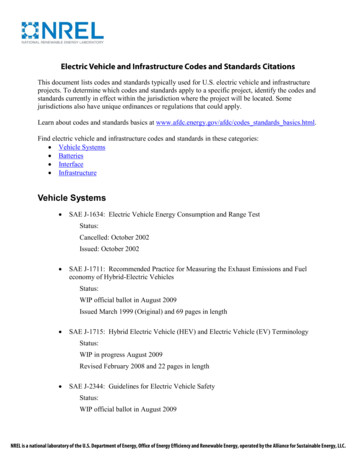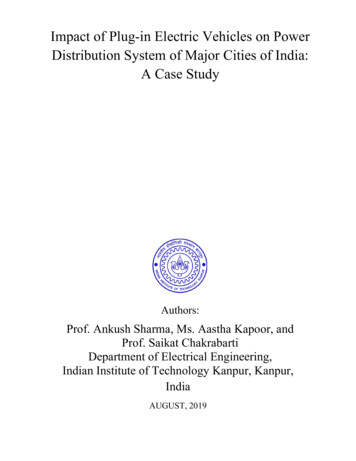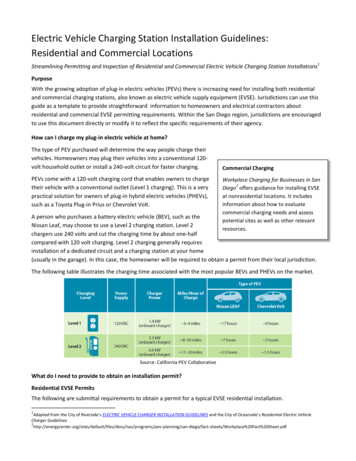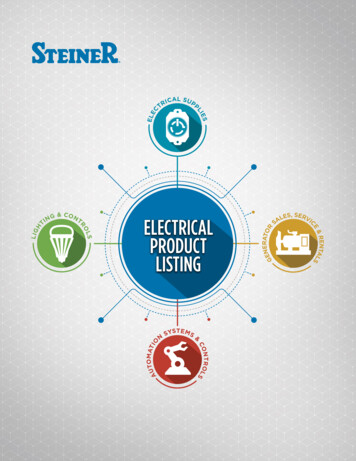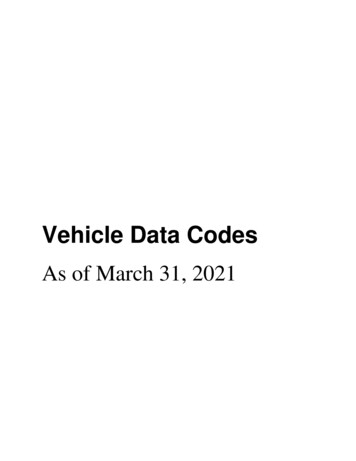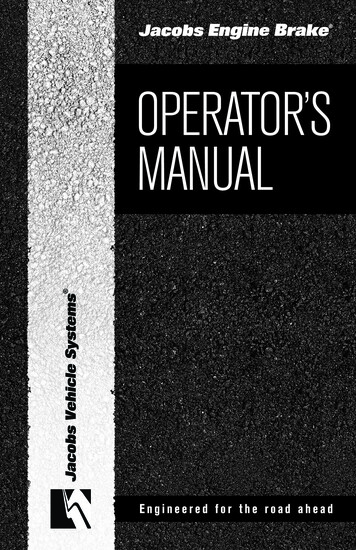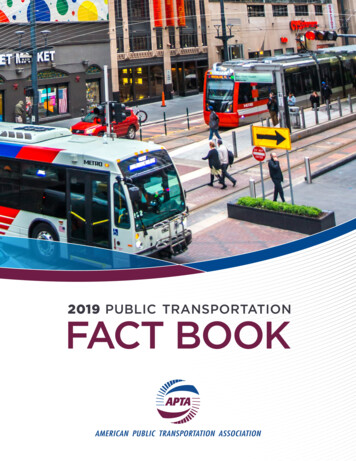
Transcription
ELECTRIC VEHICLEINFRASTRUCTUREINSTALLATION GUIDEMarch 1999Edition
Pacific Gas and Electric CompanyElectric Vehicle Infrastructure Installation GuideElectrical ContractorsCity and County Building InspectorsEVSE InstallersArchitects and EngineersPacific Gas and Electric Company EmployeesMarch 19991999 EditionThe Electric Vehicle Infrastructure Installation Guide is an overview of policies, requirements and codes for establishing electric service and for the installation of electric vehicle charging equipment.In addition to the utility requirements, local or state officials maystipulate additional provisions for the installation of equipment andmaterials which are in their authorized areas of responsibility and jurisdiction.Should you have any questions regarding this book, please contact the Clean Air Transportation Department of Pacific Gas and Electric Company at 800 684-4648.Final customer electric service and meter installation requirements are subject to prior Pacific Gas and Electric Company reviewand approval
Copyright 1999by Pacific Gas and Electric CompanyAll rights reservedNo part of this book may be reproduced in any form,whatsoever, without written permission from Pacific Gas andElectric Company.Pacific Gas and Electric CompanyClean Air Transportation DepartmentMail Code H28LP.O. Box 770000San Francisco, CA 94177Produced byClean Air Transportation Department
TABLE OF CONTENTSPage1. Introduction.1A. EV Infrastructure Essentials .1B. Information Resources.22. EV Charging Essentials .3A. Rules and Regulations Governing EV Infrastructure Installations.31. The National Electrical Code (NEC).32. The California Electrical Code (CEC) .43. Local Codes and Ordinances.44. UL Listing.45. Installation Plans.56. Equipment Certification.5B. EV Charging Levels .51. Level 1 Charging .52. Level 2 Charging .63. Level 3 Charging .6C. Charger Technologies: Conductive and Inductive .61. Conductive Technologies.62. Inductive Technologies.7D. Charging Equipment Currently Available.7E. PG&E EV Rates.93. Code Requirements for Installing EVSE .12A. EVSE Used in Level 1 Installations .12B. EVSE Used in Level 2 Installations .13C. Installations Where Ventilation is Required.14D. Codes Governing EVSE Siting.15E. Installations Located in Flood Zones.16F. Required Signage.16G. Lighting Recommendations .17H. Disable Access.184. EV Charging in Single Family Residences .19A. Step 1: Determine the Charging and Battery Types.19B. Step 2: EV Utility Rates and Meter Options .19C. Step 3: Determine the Home’s Electrical Capacity .19D. Step 4: Determine EVSE Placement .191. Safety Issues in Enclosed Garages .202. Extending Electrical Service .203. Outdoor Charging .20E. Step 5: Drawing Up the Installation Plans .20F. Step 6: Obtaining Permits, Performing the Installation, and Conducting aSite Inspection .21
G. Other Issues Pertaining to Single Family Residences .211. Insurance.212. Costs .21H. Single-Family Residence EVSE Installation Checklist23I. Issues Related to Installations in Multifamily Residences.251. Ownership of EVSE .252. Apartments.253. Condominiums and Townhouses.254. Metering Arrangements .255. Electrical Capacity.266. Insurance.267. Costs .265. EV Charging at Fleet Facilities.27A. Site Planning .271. Number of EVs and Chargers .272. Convenience.283. Cable Management .294. Ventilation Needs .295. Battery Operating and Charging Temperature Limits .296. Standing Water and Irrigation.297. Curbs, Wheel Stops, and Setbacks .298. Vandalism .299. Signs .2910. Disabled Access.29B. Checklist for Fleet Facility EVSE Siting.30C. Engineering and Construction.30D. Charging Equipment.31E. Fleet Recharge Management Systems .31F. Metering and Billing Systems .32G. Electrical Service.33H. Electric Rates.33I. Site Installation Plan .33J. Building Permits .34K. Costs.34L. Checklist for Vehicle Fleet Charging.366. Public Access and Commercial Charging Installations .39A. Local Codes and Regulations.39B. Payment of Charging Services .39C. Types of Chargers and Level of Charging .39D. EVSE Siting Decisions.39E. Electrical Service Adequacy.40F. Electric Rates.40G. Prevention of Vandalism.40H. Lighting .41I. Creating the Site Plan .41
J. Installation Costs .41K. Checklist for Public Access and Commercial Charging Installations .41Appendix A. Public Charging Locations Currently in Operation .43L. Inductive Sites .43M. Conductive Charging Sites.44Appendix B. Building Code Contacts in Major Cities.46Appendix C. Glossary of EV Terms.47Appendix D. References .50
.TABLE OF FIGURESFigure 1: Typical Residential EV Charging Infrastructure.2Figure 2: Conductive and Inductive Level 2 Connectors .7Figure 3: Options for Installing Dual Meter Adapters (Where Allowable).11Figure 4: Typical Signs Used with EVSE and Charging Locations .16Figure 5: Typical Parking layout for Disable access.18Figure 6: Sample Residential EV Infrastructure Plan .22
1. INTRODUCTIONThe introduction of electric vehicles (EVs) in Northern California brings a challenging set of planning, regulatory, and cost issues. Because EVs require a unique infrastructure—including specialized charging equipment and adequate electric service—most users, as well as infrastructureinstallers and PG&E staff, are not familiar with charging basics. This guide provides the necessaryinformation all users, installers, and PG&E need to better handle the task of installing the appropriate equipment for residential and fleet EV customers.The guide’s introduction defines key terms and responsibilities, and gives other sources of information. Chapter 2 discusses the safety codes governing EV charging equipment, electrical requirements, equipment options, and PG&E rates for EVs. Chapter 3 details the electrical andbuilding code requirements that apply to all installers and users of electric vehicle supply equipment (EVSE). The remaining chapters discuss the special needs of the different classes of EV users: homeowners (including multifamily residences), fleet facilities, and public access andcommercial charging facilities.For fleet users, the Energy Policy Act of 1992 (EPAct) requires fuel providers to include alternative fuel vehicles (AFVs) in their replacement vehicle purchases beginning in 1996. PG&E hasopted to use EVs to meet part of this requirement. EPAct also sets guidelines for federal, state,local, and private fleets to include AFVs when purchasing replacement vehicles, and many ofthese organizations also plan to buy EVs. As a result, the installation of EVSE has become animportant issue to many fleet managers today.For residential customers, infrastructure issues are less complex in terms of siting, equipment selection, and load management. In addition, EV manufacturers provide ample information and assistance concerning EVSE placement and installation. However, municipalities in PG&E’sservice territory treat metering issues differently. This guide addresses the practices in a few citiesand provides names of relevant code officials.A.EV Infrastructure EssentialsEV infrastructure is comprised of the following components:x EVSE, including a charger, cable, and connectorx Premises wiring that runs from the customer meter to the EVSEx Electrical service, including PG&E power lines and the customer meterPG&E provides installation advice and assistance (call PG&E’s Clean Air Transportation Hotlineat 800-684-4648) but the EV owner is ultimately responsible for the installation and operation ofthe EVSE, as well as for any upgrades or improvements to the premises wiring. EV owners mustobtain the appropriate building permits and ensure that a qualified licensed contractor or electricianperforms the installation. EV dealerships offer assistance in finding contractors for these installationEV Infrastructure Installation Guide1
services. The following figure illustrates a typical residential charging set-up and the responsibilities ofeach component.Figure 1: Typical Residential EV Charging InfrastructureEV SupplyEquipmentPremisesWiringJunctionBoxVehicleEV SupplyEquipmentEV OwnerPremises WiringElectricalServiceUtilityPG&E owns, installs, and maintains the electric service to the customer meter, in addition to providing electricity. For residences, PG&E offers special EV time-of-use (TOU) rates that provideincentives to charge EVs off-peak. To take advantage of some of the special rates, the EV ownermay want install a second meter for the EVSE circuit (see Chapter 2E, PG&E EV Rates, for moreinformation).B.Information ResourcesThese guidelines should not be considered the sole source of information related to installingEVSE and charging equipment. EV and EVSE manufacturers and dealers are the best sources ofinformation on the infrastructure needs and regulatory requirements particular to their equipment.They can also provide information on ordinances in local jurisdictions, which may impose additional requirements.Any EV infrastructure installer should follow guidelines provided by manufacturers of the EV, thecharging equipment, and the EV battery. In almost all cases, EV infrastructure installation requires permits and inspection by local building or electrical code officials. Installations should always be performed by licensed contractors.EV Infrastructure Installation Guide2
2. EV CHARGING ESSENTIALSThe codes, standards, and ordinances governing EVSE design, manufacturing, and installationmake EV charging safe. The person performing the charging is protected against electrical shockthrough the use of protection systems. Nationally recognized testing laboratories such as the Underwriters Laboratory (UL), have approved and listed EV charging components to ensure theirdurability and safety.The following is a list of standard EVSE safety features:xxxxxAn EV will not start if it is still plugged into the chargerBefore the charger can be disconnected, the cable must de-energizedThe vehicle inlet is de-energized until the driver attaches the unique connector to the vehicleThe EV connector cannot be used with other appliancesMonitors and a ground-fault circuit interrupt (GFCI) shut down the electricity supply if theysense a potential problemx For the few battery types that emit potentially explosive gases, building codes require ventilation to eliminate risks.Any variation from relevant building codes and regulations can create a potential hazard. Abusingthe equipment can also lead to trouble. All EV owners and EVSE installers must note that abuilding permit is required for EVSE installations and should adhere strictly to the applicablecodes, standards, and ordinances.A.Rules and Regulations Governing EV Infrastructure InstallationsIn most circumstances, local building officials will not issue permits for installing EVSE withoutfirst seeing plans showing compliance with applicable codes and ordinances. Compliance with local and state regulations is necessary to pass the building inspector’s post-installation inspection.California and federal codes that regulate charger installation are described below.1.The National Electrical Code (NEC)The National Fire Protection Association’s National Electrical Code (NEC) sets standards forelectrical construction and operation. The NFPA revises and publishes a new National ElectricalCode Handbook every three years. The 1999 NEC update covers EV charger installation issues inChapter 6, Article 625.The 1999 NEC update has added new language to two sections of Article 625. Article 625-22calls for personnel protection systems for EV charging systems to replace ground-fault currentinterrupter devices to protect from shock. Article 625-29(d)(3) provides an alternate method fordetermining indoor ventilation levels.EV Infrastructure Installation Guide3
2.The California Electrical Code (CEC)The 1998 California Electrical Code (CEC), administered by the California Building StandardsCommission and the state Fire Marshall's office, mirrors the NEC. Variations with the NEC werereconciled in 1998.Chapter 3 provides a summary of the CEC.3.Local Codes and OrdinancesLocal jurisdictions can either adopt the national or state codes, or enact regulations that are morestringent. Some California counties, such as Sacramento County, passed ordinances requiringconduits for EV charging in new residential construction. These ordinances will save owners timeand money when they want to install EVSE.Some of the larger cities in Northern California have regulations prohibiting residences from installing dual meter adapters. These adapters are necessary to take advantage of certain specialtime-of-use rates (see Chapter 2E), which are particularly important to EV users.A selection of cities in PG&E’s service territory were contacted regarding their permitting practices for EV charging facilities and EVSE. The following table illustrates their policies towardresidential dual meter adapters.CitySan FranciscoOaklandSan JoseBakersfieldFresnoStocktonModestoDual Meter orAdapter?YesNoXXReasonNotAllowed *XXULListingXCommentsAllowed forvehicles onlyXXXXXXXHomeownerscan apply forvariance* Ordinance or building code restrictions due to zoning, etc.EV purchasers and installers should contact their local City/County Building Department to verifythat dual meter adapters are allowed in their area if considering separately metering the EVSE.4.UL ListingDual meter adapters are currently not listed by Underwriters Laboratory (UL). UL is performingtests on the equipment and hopes to complete the listing by the end of 1999. However, their useis regulated by local building authorities as illustrated in the previous table. While only one of thecities contacted restrict dual meter adapter use on the basis of non-listing by UL, several prohibitthe use of multiple meters in order to protect against illegal housing units (“in-law” units).EV Infrastructure Installation Guide4
5.Installation PlansMost local jurisdictions require EV owners to submit building or electrical plans as part of thepermit process. These plans can include:x A plan or one-line diagram showing the service panel schedule and branch circuit locationx A diagram describing the ventilation system, including location of the EVSE, air inlet, and exhaust fan may be required when EV batteries requiring ventilation are used.6.Equipment CertificationThe local building inspector will verify that components are approved, or UL-listed and labeled.According to NEC, approved means “acceptable to the authority having jurisdiction.”B.EV Charging LevelsEV charging is performed at three voltage and current levels. The levels are defined to meet thecurrent EV’s needs, to meet anticipated future technologies’ needs, and to provide compatibilitywith the nation’s electric transmission and distribution system. The 1999 NEC Handbook describes the three charging levels. Levels 2 and 3 require dedicated EVSE. The sections below describe each charging level in greater detail. The following table summarizes the electricalrequirements of the three charging levels.Level 1Level 2Level lethreeStandardOutletNEMA 5-15RSAE J1772/3N/A1.Level 1 ChargingLevel 1 charging uses a common 120-volt, single-phase outlet for a three-prong grounded(NEMA 5-15R) connector with ground-fault circuit interrupt. Level 1 charging requires 8 to 14hours to fully charge a vehicle, depending on the EV and battery type. One advantage of Level 1charging equipment is that it eliminates the need for upgrades to the current electrical service. Themain disadvantage is that it is insufficient to provide a full charge to an EV within 4 to 6 hours.Level 1 charging electrical specifications include:x 120-volt ac single-phase maximum nominal supplyx 12 amps maximum continuous current with 15 amps (minimum) branch circuit protectionThe maximum continuous current and branch circuit protection values are based on compatibilitywith the existing electric supply infrastructure.EV Infrastructure Installation Guide5
2.Level 2 ChargingWhen using Level 2 charging, an EV can be charged in 4 to 6 hours, depending on the EV, battery type, and capacity.Level 2 charging electrical specifications include:x 208-240 volts ac single-phase maximum nominal supplyx 32 amps maximum continuous current with 40 amps branch circuit protectionOther required features for Level 2 charging include grounding or electrical isolation, personnelprotection from shock, a no-load make/break interlock, and a safety breakaway for the cable andconnector.3.Level 3 ChargingLevel 3, or fast charging, requires high levels of voltage and current to replenish more than half ofan EV’s battery capacity in as quickly as ten minutes. Tests of Level 3 charging have taken placeand a commercial charger was recently made available. However, there are no public chargingsites using Level 3 charging in PG&E’s service territory as of March 1999.Level 3 chargers use a 480-volt ac, 400-amp, three-phase electrical service and require the samesafety features as Level 2 EVSE.C.Charger Technologies: Conductive and InductiveCurrently there are two technologies being used to connect EVs to the EVSE: conductive andinductive. Both are available for all levels of charging.EVs will only use one of these technologies since they are incompatible. A vehicle using one technology typically cannot be connected to a charger with the other technology because they employdifferent connectors. Each technology has its strengths and weaknesses as listed in the followingtable:IssueSafetyEnergy EfficiencyCostInductiveNo differenceNot as efficient as conductive chargingComplexity of system makesit more expensiveConductiveNo differenceMore efficientSimpler system makes it lessexpensive1.Conductive TechnologiesConductive charging uses physically connecting contacts, similar to methods used by commonappliances. It is the method used by most on-board chargers, or systems that place the chargingcircuitry and control on the vehicle. The connector for these systems is usually a butt-type connector.EV Infrastructure Installation Guide6
Some off-board chargers, or systems that place the charging circuitry and controls off-board thevehicle in a charging stand, also use conductive coupling. In this case, the charger communicateswith the battery and vehicle electronics over the communications wiring in the connector.2.Inductive TechnologiesInductive charging systems transfer ac power by magnetically coupling a primary winding on thesupply side to a secondary winding on the vehicle side. Current flows through the primary inductor coil, or paddle, and the resulting magnetic flux induces an alternating current through themagnetic field and across the secondary coil, completing the circuit. The ac current is convertedto dc for storage in the vehicle battery.Inductive chargers keep most of the charging circuitry and controls in an off-board chargingstand, and communicate with the battery and vehicle electronics via infrared or radio frequencies.Figure 2: Conductive and Inductive Level 2 ConnectorsD.Charging Equipment Currently AvailableAs of March 1999, the following EVSE are available in PG&E’s service territory (listed bymanufacturer):EV Infrastructure Installation Guide7
x AVCONProduct Name: EV Power PakCharging Type: ConductiveCharging Level: Level IIPrice: 295Contact: Kristine Todryke, AVCON - 800/433-7642Comments: Price includes shipping and handlingx AerovironmentProduct Name: PosiChargeCharging Type: ConductiveCharging Level: Level III (fast charge)Price: Model PC 60100 (60 kW) - 40,000 available with 240v and 480v utility connections;(120 kW) - 80,000 available with 240v and 480v utility connectionsContact: Jon Bertolino, Sacramento Municipal Utility District (SMUD), 916/732-6980 forNorthern California and Nevada; Marc Cortez, Aerovironment, 626/357-9983 x311 for SouthernCalifornia and ArizonaComments: The 60 kW unit has a UL listing but the 120 kW unit does not. Aerovironment alsooffers battery management systems (BMS) for OEM electric vehicle and EV conversions so theycan use PosiCharge. The cost of a BMS unit starts at 2,200.x Electric Vehicle Infrastructure, Inc. (EVI)Product Name: Model ICS-200BCharging Type: ConductiveCharging Level: Level IIPrice: Model ICS-200B, single outlet, wall mounted - 1,800; Model ICS-200B, single outletwith pedestal - 2,205; Model ICS-200B dual outlets, with pedestal - 4,120Contact: Edison EV - 888/890-GOEV or ETEC - 888/383-2387Comments: EVI ‘s chargers can come with additional optionsx General Motors ATVProduct Name: Magne ChargeCharging Type: InductiveCharging Level: Level IIPrice: Wall mounted unit - 1,995; Floor/pedestal unit - 3,285Contact: Edison EV - 888/890-GOEVComments: Chargers are 7.5 kW. GM ATV has a fast charger in demonstration but not availablefor purchase.EV Infrastructure Installation Guide8
x Lockheed MartinProduct Name: 14.4 kW Conductive Charger StationCharging Type: ConductiveCharging Level: Level IIPrice: Not available. See comments belowContact: Edison EV - 888/890-GOEV or ETEC - 888/383-2387Comment
stallation Guide Electrical Contractors City and County Building Inspectors EVSE Installers Architects and Engineers Pacific Gas and Electric Company Employees March 1999 1999 Edition The Electric Vehicle Infrastructure Installation Guide is an over-view of policie

